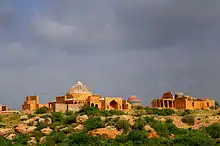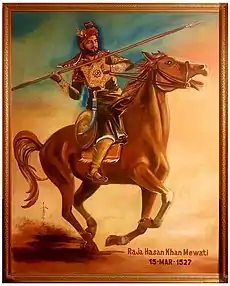Muslim Rajputs
Muslim Rajputs are the descendants of Rajputs of Northern regions of the Indian subcontinent who are followers of Islam.[1] They converted from Hinduism to Islam during the medieval period in India, retaining their surnames such as Chauhan.[2][3][4] Today, Muslim Rajputs can be found in present-day Northern India and eastern parts of Pakistan.[5] They are further divided into different clans.
.tiff.jpg.webp) Mussulman Bukiyana Rajpoots from Mooltan | |
| Total population | |
|---|---|
| 19,606,500 | |
| Regions with significant populations | |
| |
| Pakistan | 16,680,000 |
| India | 2,893,000 |
| Nepal | 16,000 |
| Bangladesh | 16,000 |
| Sri Lanka | 1,500 |
| Languages | |
| |
| Religion | |
| Islam | |
| Related ethnic groups | |
| Rajputs | |
History
.tiff.jpg.webp)
The term Rajput is traditionally applied to the original Suryavanshi, Chandravanshi and Agnivanshi clans, who claimed to be Kshatriya in the Hindu varna system.
Conversion to Islam and ethos
There are recorded instances of recent conversions of Rajputs to Islam in Western Uttar Pradesh, Khurja tahsil of Bulandshahr.[6]
Upon their conversion from Hinduism to Islam,[2] the Rajputs maintained many of their Hindu customs.[7]
Despite the difference in faith, where the question has arisen of common Rajput honour, there have been instances where both Muslim and Hindu Rajputs have united together against threats from external ethnic groups.[8]
Soomra dynasty period
When Sindh was under the Arab Umayyad Caliphate, the Arab Habbari dynasty was in control. The Umayyads appointed Aziz al Habbari as the governor of Sindh. Habbaris ruled Sindh until Sultan Mahmud Ghaznavi defeated the Habbaris in 1024. Sultan Mahmud Ghaznavi viewed the Abbasid Caliphate to be the caliphs thus he removed the remaining influence of the Umayyad Caliphate in the region and Sindh fell to Abbasid control following the defeat of the Habbaris. The Abbasid Caliphate then appointed Al Khafif from Samarra; 'Soomro' means 'of Samarra' in Sindhi. The new governor of Sindh was to create a better, stronger and stable government. Once he became the governor, he allotted several key positions to his family and friends; thus Al-Khafif or Sardar Khafif Soomro formed the Soomro Dynasty in Sindh;[9] and became its first ruler. Until the Siege of Baghdad (1258) the Soomro dynasty was the Abbasid Caliphate's functionary in Sindh, but after that it became independent.
When the Soomro dynasty lost ties with the Abbasid Caliphate after the Siege of Baghdad (1258,) the Soomra ruler Dodo-I established their rule from the shores of the Arabian Sea to the Punjab in the north and in the east to Rajasthan and in the west to Pakistani Balochistan. The Soomros were one of the first indigenous Muslim dynasties in Sindh of Parmar Rajput origin.
Samma Dynasty period

In 1339 Jam Unar founded a Sindhi Muslim Rajput Samma Dynasty and challenged the Sultans of Delhi. He used the title of the Sultan of Sindh. The Samma tribe reached its peak during the reign of Jam Nizamuddin II (also known by the nickname Jám Nindó). During his reign from 1461 to 1509, Nindó greatly expanded the new capital of Thatta and its Makli hills, which replaced Debal. He patronized Sindhi art, architecture and culture. The Samma had left behind a popular legacy especially in architecture, music and art. Important court figures included the poet Kazi Kadal, Sardar Darya Khan, Moltus Khan, Makhdoom Bilawal and the theologian Kazi Kaadan. However, Thatta was a port city; unlike garrison towns, it could not mobilize large armies against the Arghun and Tarkhan Mongol invaders, who killed many regional Sindhi Mirs and Amirs loyal to the Samma. Some parts of Sindh still remained under the Sultans of Delhi and the ruthless Arghuns and the Tarkhans sacked Thatta during the rule of Jam Ferozudin.
Kharagpur Raj
The Kharagpur Raj was a Muslim Kindwar Rajput chieftaincy in modern-day Munger district of Bihar.[10][11] Raja Sangram Singh led a rebellion against the Mughal authorities and was subsequently defeated and executed. His son, Toral Mal, was made to convert to Islam and renamed as Roz Afzun. Roz Afzun was a loyal Commander to the Emperors Jahangir and Shah Jahan and Jahangir referred to him as his "favourite" commander in the empire.[12] Another prominent chieftain of this dynasty was Tahawar Singh who played an active role in the Mughal expedition against the nearby Cheros of Palamu.[13]
Gujarat Sultanate
The Gujarat Sultanate was an independent Muslim Rajput kingdom established in the early 15th century by the Muzaffarid dynasty in Gujarat. The Muzaffarids were descended from Hindu Tanka Rajputs with origins in Thanesar in modern-day Haryana.[14] Under the dynasty, trade, culture, and Indo-Islamic architecture flourished. The city of Ahmedabad was founded by the dynasty.
Khanzada Dynasty

Mewat was a kingdom in Rajputana with its capital at Alwar ruled by a Khanzada Rajput dynasty during the period of the Delhi Sultanate in India. Mewat was covered over a wide area, it included Hathin tehsil, Nuh district, Tijara, Gurgaon, Kishangarh Bas, Ramgarh, Laxmangarh Tehsils Aravalli Range in Alwar district and Pahari, Nagar, Kaman tehsils in Bharatpur district of Rajasthan and also some part of Mathura district of Uttar Pradesh. The last ruler of Mewat, Hasan Khan Mewati was killed in the battle of Khanwa against the Mughal emperor Babur. The Khanzadas were descended from Hindu Jadaun Rajputs.[15]
Qaimkhanis of Fatehpur-Jhunjhunu
The Qaimkhanis were a Muslim Rajput dynasty who were notable for ruling the Fatehpur-Jhunjhunu region in Rajasthan from the 1300s to the 1700s.[16][17] They were descended from Hindu Chauhan Rajputs.
Lalkhani Nawabs
The Lalkhanis are a Muslim Rajput community and a sub-clan of the Bargujars. They were the Nawabs of various estates in Western Uttar Pradesh. These included Chhatari and neighbouring regions including parts of Aligarh and Bulandshahr.[18]
Mayi chiefs
The Mayi clan were the chieftains of the Narhat-Samai (Hisua) chieftaincy in modern-day Nawada district in South Bihar. The founder of the Mayi clan was Nuraon Khan who arrived in Bihar in the 17th century. His descendants were Azmeri and Deyanut who were granted zamindari rights over six parganas by the Mughal authorities. Deyanut's son was Kamgar Khan who expanded his land by attacking and plundering neighbouring zamindars. Kamgar Khan also led numerous revolts against the Mughals and attempted to assert the Mayi's independence. His descendant was Iqbal Ali Khan who took part in the 1781 revolt in Bihar against the British however his revolt failed and Mayi's lost much of their land.[19]
Notable people in medieval India
- Dodo Bin Khafef Soomro III
- Jam Tamachi (Jam Khairuddin) (1367–1379 AD) or Jam Khairuddin bin Jam Unad, a famous sultan of the Samma dynasty
- Jam Nizamuddin II (866–914 AH, 1461–1508 AD), the most famous sultan of the Samma dynasty
- Jam Ferozudin (1508–1527) or Jam Feruz bin Jam Nizam, last ruler of the Samma dynasty 926 AH (1519 AD)
- Raja Hasan Khan Mewati, was the ruler of Mewat
- Isa Khan, was the Chief of the Baro Bhuiyans (twelve landlords) of 16th century Bengal. His grandfather was a Bais Rajput from Ayodhya in modern-day Uttar Pradesh who migrated to Bengal. Throughout his reign he resisted the Mughal Empire.
- Rai Bular Bhatti, he donated 18,750 acres of land to Guru Nanak Ji.
- Dulla Bhatti, who rebel against Akbar.
- Mahmud_Begada
Beliefs and customs
Muslim Rajputs often retain common social practices (such as purdah [seclusion of women], which is generally followed by Hindu and Muslim Rajputs).[5]
Numbers
Joshua Project, a Christian missionary organisation with both global and local ethnological data’s or sources, estimates the population of Muslim Rajputs to constitute 25% of the total Rajput population in South Asia, numbering 19,6 millions in total, the majority or 16,6 millions being in Pakistan (of which 9 millions are in Punjab and 6 millions in Sindh), followed by India with 2,8 millions of Muslim Rajputs (more than half of them being in Uttar Pradesh), while few thousands live in Nepal and Bangladesh (both 16,000) followed by 1,500 in Nepal.[20]
See also
- List of Rajput dynasties
- Sindhi-Sipahi
References
- "UNHCR Refugee Review Tribunal. IND32856, 6 February 2008" (PDF).
- Singhal, Damodar P. (1972). Pakistan. Prentice Hall. p. 17. ISBN 978-0-13-648477-6.
Large communities converted to Islam from among Hindus carried with them Hindu customs and usages, and often passed them on to other Muslims. Many Rajput converts even retained their family names, such as Chauhan and Rajput.
- Singh, Yogendra (1973). Modernization of Indian Tradition. Oriental Press. p. 74.
The next in status are a few higher caste Hindu converts to Islam, particularly the Rajputs
- Cambridge South Asian Studies, Issue 16. 1965. p. 24. ISBN 978-0-521-20432-3.
The latter may be subdivided into three distinct groups: converts from Hindu high castes such as Muslim Rajputs, converts from clean occupational castes such as Julahas and Qassabs, and converts from unclean occupational castes such as Bhangis and Chamars.
- "Rajput". Encyclopædia Britannica. Retrieved 30 October 2014.
- Muslim Women by Zakia A. Siddiqi, Anwar Jahan Zuberi, Aligarh Muslim University, India University Grants, M.D. Publications Pvt. Ltd., 1993, p93
- Singh, Kumar Suresh (2003). People of India, Volume 25. Anthropological Survey of India. p. xxiii. ISBN 978-81-7304-118-1.
In early stages the converted Rajputs continued with preconversion practices.
- Self and sovereignty: Individual and Community in South Asian Islam Since 1850 by Ayesha Jalal, Routledge 2000, p480, p481
- "Data" (PDF). www.uok.edu.pk.
- Tahir Hussain Ansari (20 June 2019). Mughal Administration and the Zamindars of Bihar. Taylor & Francis. pp. 22–28. ISBN 978-1-00-065152-2.
- Yogendra P. Roy (1999). "Agrarian Reforms in "Sarkar" Munger under Raja Bahrox Singh (1631-76) Of Kharagpur". Proceedings of the Indian History Congress. 60: 287–292. JSTOR 44144095.
- Yogendra P. Roy (1993). "Raja Roz Afzun of Kharagpur (AD 1601 - 31". Proceedings of the Indian History Congress. 54: 357–358. JSTOR 44142975.
- Yogendra P. Roy (1992). "Tahawar Singh-A Muslim Raja of Kharagpur Raj (1676 - 1727)". Proceedings of the Indian History Congress. 53: 333–334. JSTOR 44142804.
- Aparna Kapadia (16 May 2018). Gujarat: The Long Fifteenth Century and the Making of a Region. Cambridge University Press. pp. 183–185. ISBN 978-1-107-15331-8.
- Bharadwaj, Suraj (2016). State Formation in Mewat Relationship of the Khanzadas with the Delhi Sultanate, the Mughal State, and Other Regional Potentates. Oxford University Press. p. 11. Retrieved 24 October 2019.
- Sunita Budhwar (1978). "The Qayamkhani Shaikhzada Family of Fatehpur-Jhunjhunu". Proceedings of the Indian History Congress. 39: 412–425. JSTOR 44139379.
- Dr Dasharatha Sharma, Kyam Khan Raso, Ed. Dasharath Sharma, Agarchand Nahta, Rajsthan Puratatva Mandir, 1953, page-15
- Eric Stokes (1978). The Peasant and the Raj: Studies in Agrarian Society and Peasant Rebellion in Colonial India. CUP Archive. pp. 199–. ISBN 978-0-521-29770-7.
- Gyan Prakash (30 October 2003). Bonded Histories: Genealogies of Labor Servitude in Colonial India. Cambridge University Press. pp. 87–89. ISBN 978-0-521-52658-6.
- "Rajput (Muslim traditions)". Joshua Project. Retrieved 10 January 2021.